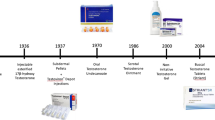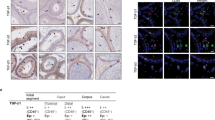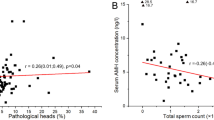Abstract
THE formation of testosterone by the testis has been studied extensively and the general characteristics of the process have been described1. But the mechanism by which testosterone escapes from the steroidogenic cell and then from the testis is largely unknown2. Eik-Nes3 speculated that testosterone secretion could be explained by the presence of plasma constituents which bind the hormone. These plasma constituents might include erythrocytes, albumin and sex-hormone-binding globulin which have association constants for testosterone of 1×103 (ref. 4), 3×104 (ref. 5) and 1×109 (ref. 6), respectively. On the basis of this information, we hypothesised that testosterone secretion is dependent on diffusion from the steroidogenic cell into the blood and that this diffusion is enhanced by the presence of steroid-binding macromolecules in the blood. We report here a test of this hypothesis.
This is a preview of subscription content, access via your institution
Access options
Subscribe to this journal
Receive 51 print issues and online access
$199.00 per year
only $3.90 per issue
Buy this article
- Purchase on Springer Link
- Instant access to full article PDF
Prices may be subject to local taxes which are calculated during checkout
Similar content being viewed by others
References
Eik-Nes, K. B., in The Androgens of the Testis (edit. by Eik-Nes, K. B.), 1–41 (Dekker, New York, 1970); Rec. Prog. Norm. Res., 27, 517–535 (1971).
Christensen, A. K., in The Handbook of Physiology, Section 7, 5 (edit. by Greep, R. O., and Astwood, E. B.), 57–94 (American Physiological Society, Washington DC, 1975).
Eik-Nes, K. B., in The Handbook of Physiology, Section 7, 5 (edit. by Creep, R. O., and Astwood, E. B.), 95–115 (American Physiological Society, Washington DC, 1975).
Brinkman, A. D., Mulder, L., and Van der Molen, H. J., Ann. Endocr., 31, Suppl. 4, 789–801 (1970).
Daughaday, W. H., J. Clin. Invest., 37, 511–518 (1958).
Mercier-Bodard, C., Alfsen, A., and Baulieu, E. E., Acta Endocr., Suppl., 142, 204–224 (1970).
VanDemark, N. L., and Ewing, L. L., J. Reprod. Fertil., 6, 1–8 (1963).
Ewing, L. L., and Eik-Nes, K. B., Can. J. Biochem., 44, 1327–1344 (1966).
Ewing, L. L., in Hormonal Regulation of Spermatogenesis (edit. by French, F. S., Hansson, V., Ritzen, E. M., and Nayfeh, S. N.), 145–164 (Plenum, New York, 1975).
Ewing, L. L., Brown, B., Irby, D. C., and Jardine, I., Endocrinology, 96, 610–617 (1975).
Westphal, U., Meth. Enzymol, 15, 761–796 (1969).
Westphal, U., in Normal and Abnormal Growth of the Prostate (edit. by Goland, M.), 616–657 (Thomas, Springfield, Illinois, 1974).
Author information
Authors and Affiliations
Rights and permissions
About this article
Cite this article
EWING, L., CHUBB, C. & ROBAIRE, B. Macromolecules, steroid binding and testosterone secretion by rabbit testes. Nature 264, 84–86 (1976). https://doi.org/10.1038/264084a0
Received:
Accepted:
Issue Date:
DOI: https://doi.org/10.1038/264084a0
This article is cited by
-
Autoregulation of androgen production in a primary culture of rat testicular cells
Nature (1981)
-
Zur Bindung von Steroidhormonen an Serumproteine
Klinische Wochenschrift (1977)
Comments
By submitting a comment you agree to abide by our Terms and Community Guidelines. If you find something abusive or that does not comply with our terms or guidelines please flag it as inappropriate.



